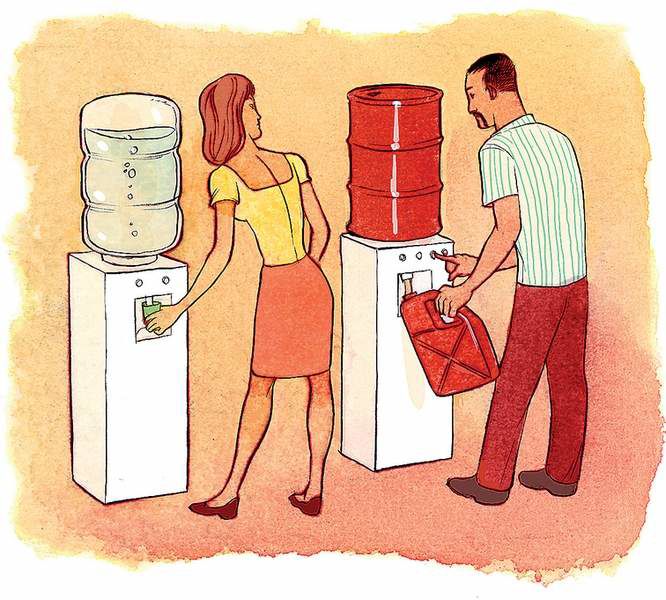Work-life balance? Try work-gas balance
Published 5:00 am Thursday, August 7, 2008

- Illustration by Koren Shadmi / New York Times News Service
In Washington state, Microsoft has leased three large office complexes miles from company headquarters in recent months to shorten the commutes of about 7,000 employees.
In San Francisco, Citigate Cunningham, a public relations company, now encourages workers to stay home whenever possible, providing laptop computers and BlackBerrys to enable telecommuting, and reimbursing them $40 a month for high-speed Internet connections in their homes.
At Rejuvenation, a lighting manufacturer in Portland, employees skip one day of work completely. The company has gone to a four-day week, with each workday being 10 hours long. Alysa Rose, the president, also gives away a free bicycle to an employee every month.
Nationwide, workers are being presented with free gas cards, subsidized bus passes, more money in their paychecks, and the opportunity to turn their cars into company billboards (with the company often picking up all fuel costs, not just miles spent commuting).
Gasoline has become the new workplace perk, as employers scramble to help workers cut its use and cost. A dollar a gallon ago, things like telecommuting, shortened workweeks and Internet subsidies were ways of saving time and providing workers with a little more balance in their lives. Now they have become ways to save money and to keep workers from, well, walking.
“We had 14 calls last week and nine of those named high gas prices as their number one reason for leaving their job,” said Lauren Milligan, who helps job-seekers polish their resumes at ResuMayDay, a career-management services company in Warrenville, Ill. “Employers have to start paying attention.”
Some employers have come to the same conclusion. “We need to stay competitive and viable,” said David Lewis, the president of OperationsInc., a human resource consultancy in Stamford, Conn., where, since June, employees receive up to $100 a month on an American Express cash card to offset rising gas prices.
“An extra $100 a month for gas and you have a real issue that could result in turnover,” Lewis explained, adding that even with rising unemployment, it is more economical for him to retain workers than hire new people and train them.
Richard Holtz, the president of InfiniSys, which designs technology systems for buildings, and has offices in Daytona Beach, Fla., also sees cushioning the effect of rising gas prices as a cost of doing business.
To stay competitive, he decided he had to help his workers, who were spending about 15 percent of their salaries on commuting. He switched to a four-day workweek, gave everyone a small raise (25 cents an hour) and began paying for home Internet to foster telecommuting.
Companies that would prefer that workers come in daily are helping to pay the cost of getting them there. Bayless Engineering and Manufacturing, based in the Santa Clarita Valley of California, has about a dozen employees who live 50 miles away in the Antelope Valley. This year the company created a van pool — a rental from Enterprise — to transport them to work and back.
HotBox Pizza, a four-store chain in Indianapolis, has changed its delivery ways.
Until last month, its drivers had to use their own vehicles. But Gabe Connell, the owner, noticed that arguments were breaking out among drivers over whose turn it was to deliver to distant addresses.
So he is in the process of buying five Smart cars that get about 40 miles per gallon. The vehicles will double as rolling advertisements, because they will be painted with the chain’s red and black logo. Or with something that resembles the company logo. At HotBox the napkins say Napkin, and the shirts worn by the waiters say Shirt. So the new wheels will simply say Car.
Autos as advertising are also the approach of Jobing.com, which runs employment Web sites in 18 cities. The 297 employees at headquarters in Phoenix can apply to have their cars turned into Jobing billboards by means of an adhesive plastic skin.
In return for the publicity (and as compensation for the awkwardness of taking such a car on, say, a first date) the employee is paid $500 a month plus reimbursement for all fuel costs — both for business and personal use of the car.
The program has been in existence for more than five years, said Joe Cockrell, the director of marketing (whose Ford Escape is wrapped and who took a road trip to Sedona last weekend, with Jobing picking up the $120 he spent on gas). But this is the first year that Jobing has had a waiting list for the car makeovers.
“Gas prices are making a lot of people look at things like this differently,” Cockrell said. “It’s making everyone get creative.”






